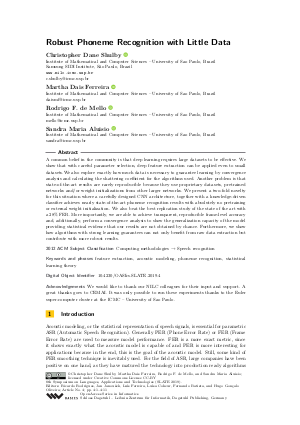@InProceedings{shulby_et_al:OASIcs.SLATE.2019.4,
author = {Shulby, Christopher Dane and Ferreira, Martha Dais and de Mello, Rodrigo F. and Aluisio, Sandra Maria},
title = {{Robust Phoneme Recognition with Little Data}},
booktitle = {8th Symposium on Languages, Applications and Technologies (SLATE 2019)},
pages = {4:1--4:11},
series = {Open Access Series in Informatics (OASIcs)},
ISBN = {978-3-95977-114-6},
ISSN = {2190-6807},
year = {2019},
volume = {74},
editor = {Rodrigues, Ricardo and Janou\v{s}ek, Jan and Ferreira, Lu{\'\i}s and Coheur, Lu{\'\i}sa and Batista, Fernando and Gon\c{c}alo Oliveira, Hugo},
publisher = {Schloss Dagstuhl -- Leibniz-Zentrum f{\"u}r Informatik},
address = {Dagstuhl, Germany},
URL = {https://drops.dagstuhl.de/entities/document/10.4230/OASIcs.SLATE.2019.4},
URN = {urn:nbn:de:0030-drops-108715},
doi = {10.4230/OASIcs.SLATE.2019.4},
annote = {Keywords: feature extraction, acoustic modeling, phoneme recognition, statistical learning theory}
}

 Creative Commons Attribution 3.0 Unported license
Creative Commons Attribution 3.0 Unported license



















